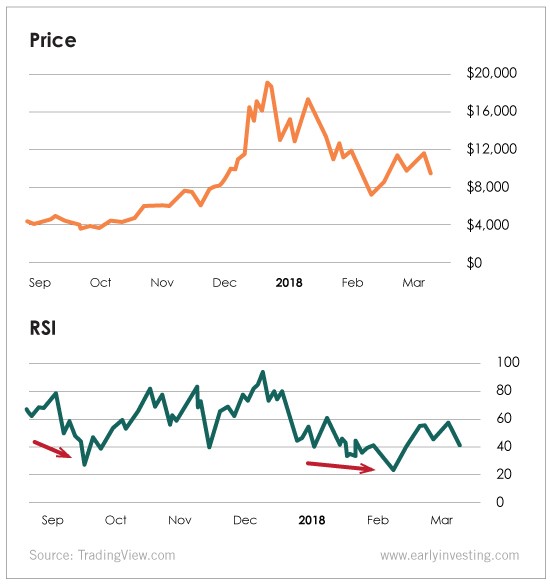When crypto volatility is high (like it is now), buying coins can be intimidating.
How can the average person hope to time it right?
If you blindly guess, you may buy a cryptocurrency only to watch it drop 25% over the next week.
That’s why I use technical analysis (TA) to help time buys. It works perfectly well with cryptocurrencies.
The most commonly used TA tool in crypto, the relative strength index (RSI), is famous for its simplicity.
It’s a momentum indicator that uses a rating scale of 1 to 100.
- Anything over 70 is overbought (expensive).
- Anything under 30 is oversold (cheap).
RSI measures recent momentum, typically over a 14-day period. It gives you a very simple way to judge if a coin is relatively cheap or expensive.
Let’s take a look at a real-world example.
Over the last year, bitcoin has entered “oversold” territory three times (on a 12 month chart)…
- July 16, 2017 – RSI hits 30, bitcoin price = $1,978 (pullback from $2,800)
- September 14, 2017 – RSI hits 30, bitcoin price = $3,849 (pullback from $4,900)
- February 6, 2018 – RSI hits 32, bitcoin price = $6,948 (pullback from $19,000).
As you can see, RSI can be a great tool for spotting dips in bitcoin. Here’s a partial chart showing the September 14 and February 6 “oversold” triggers…
As I write, on March 8, 2018, bitcoin has an RSI value of 42, meaning it’s neutral or slightly oversold at the moment.
Buying When It’s Terrifying
Buying crypto during a pullback can be hard to do. You know it’s a better time to buy than when the price is far higher, but all the news headlines are negative. For many people, it’s hard to pull the trigger in this environment.
By using a tool like RSI to gauge whether a coin is at a favorable price, we can remove the emotion from buying decisions.
You can make these types of charts for yourself at TradingView.com. You’ll need to sign up for a free account, then click the “Interactive Chart” button on the graph. Then under “Indicators,” select “Relative Strength Index.”
However, if you’re new to charting, realize that these tools aren’t magical, and that they take practice to use properly. It’s also important to know that the time period you’re looking at will affect the data. I’m a long-term investor, so I tend to look at longer periods (months or a year).
If you’re looking at a short-term chart, there will be more frequent “oversold” and “overbought” triggers. These can be useful if you don’t want to wait a long time before buying.
Due to recent increased market volatility, we’ll be paying more attention to the technical side of crypto over the coming weeks, especially in our Crypto Asset Strategies service. Keep an eye out for that.
It’s a fascinating area, and from what I’ve seen so far, TA may actually be more useful for crypto than it is for stocks.
I suspect the reason for this may be that a majority of stock volume these days is robo-trading (large algorithmic or “quant” funds), while the crypto market is still an organic market driven mainly by supply and demand… and decisions made by individuals.
Most technical analysis models are based on historical investor behavior, so it makes sense that they’d work well in a “pure” market like crypto but not as much in today’s robo-dominated, interest-rate-sensitive stock market.
Do you have any favorite technical indicators you use for crypto? Let us know in the comments.
Good investing,
Adam Sharp
Co-Founder, Early Investing
